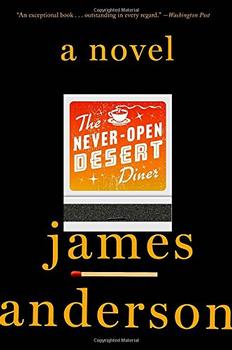Summary | Excerpt | Reading Guide | Reviews | Beyond the Book | Read-Alikes | Genres & Themes | Author Bio

This article relates to The Never-Open Desert Diner
Flash flooding is a constant concern in The Never-Open Desert Diner.
A flash flood is a sudden release of water that inundates an area, and is differentiated from a normal flood by its duration; by definition, a flash flood lasts less than six hours. Although they can occur under a wide variety of circumstances they're especially dangerous when they happen in a desert such as those in the American West. Rain in the desert is infrequent but when it falls it's generally torrential – several inches at once - and highly localized, meaning it may only be precipitating in a relatively small area. As the water collects it flows quickly downhill along channels that previous floods have cut in the sandstone – riverbeds or canyons that have been dry for months or years. The general lack of rainfall causes the ground to bake into a clay that doesn't readily absorb water, which allows the deluge to rapidly gain speed and collect accumulated debris, becoming a fast-moving wall of water and detritus that can reach 30 feet high in just a few minutes, scouring everything in its path.
Most people who die in flash floods are caught off guard; they're often tricked into a false sense of security because it's not raining where they are, and consequently fail to anticipate the danger headed their way. More people drown in the desert than die of thirst, according to the U. S. Geological Survey. Many also underestimate the power of water. It can take just six inches of moving water to knock a person off their feet and carry them away. Many people think their vehicle will keep them safe, but more than half the flood-related fatalities each year in the United States involve those who remained in their cars. A foot of water can keep a driver from being able to control their automobile, and two feet of water can completely sweep a car away.
The best bet for surviving a flash flood is to anticipate it. Visitors to the desert should never rest or camp in ditches or dry creeks, and never drive across moving water. The National Weather Service went so far as to launch a public service campaign using the slogan "Turn Around, Don't Drown!" that involved posting notices, ads, and even creating a song. The NWS is also responsible for issuing two alerts to the public: the Flash Flood Watch (conditions are right for a flash flood); and the Flash Flood Warning (a flash flood is expected or occurring).
The deadliest flash flood on record in the United States occurred along the Utah-Arizona border on September 16, 2015. Seven hikers were caught in a slot canyon in Zion National Park and another 13 were killed when their cars were overwhelmed by the water. Craig Childs, author of The Desert Cries, wrote an article describing the catastrophe and its aftermath for The High Country News:
When you see one of these floods in a narrow bedrock enclosure, it looks like madness. Wild ogres of trees and parts of cars thrust up out of nowhere, only to again disappear. Boils and waves devour each other. When the water recedes, anything but chaos remains. Sandstone walls are fluted and polished. You walk through the space as if through an art instillation.
Images of the cars washed away from Hilldale are horrific. They are mangled and crushed. These were not just drownings, they were complete destruction. Child seats were torn apart, roofs sheared off. Engines and chassis were folded around themselves and mixed with roots, packed with wet, fine sand. This is the action of 80 to 90 percent solid material mobilized by 10 to 20 percent water.
Flood waters generally recede quickly, sometimes in as little as an hour, leaving pools of muddy water that eventually drain or dry up. While deadly, this type of flood is also responsible for carving out the canyons in many of our most beautiful national parks including Zion and Arches National Parks in Utah.
Here's a video of a flash flood in Southern Utah. Go past the 1:00 minute mark:
Filed under Nature and the Environment
![]() This "beyond the book article" relates to The Never-Open Desert Diner. It originally ran in April 2016 and has been updated for the
November 2016 paperback edition.
Go to magazine.
This "beyond the book article" relates to The Never-Open Desert Diner. It originally ran in April 2016 and has been updated for the
November 2016 paperback edition.
Go to magazine.
Your guide toexceptional books
BookBrowse seeks out and recommends the best in contemporary fiction and nonfiction—books that not only engage and entertain but also deepen our understanding of ourselves and the world around us.